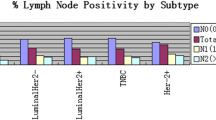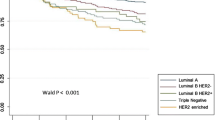Abstract
ER, PR and HER2 status in breast cancer are important markers for the selection of drug therapy. By immunohistochemistry (IHC), three major breast cancer subtypes can be distinguished: Triple negative (TNIHC), HER2+IHC and LuminalIHC (ER+IHC/HER2−IHC). By using the intrinsic gene set defined by Hu et al. five molecular subtypes (BasalmRNA, HER2+mRNA, Luminal AmRNA, Luminal BmRNA and Normal-likemRNA) can be defined. We studied the concordance between analogous subtypes and their prediction of response to neoadjuvant chemotherapy. We classified 195 breast tumors by both IHC and mRNA expression analysis of patients who received neoadjuvant treatment at the Netherlands Cancer institute for Stage II–III breast cancer between 2000 and 2007. The pathological complete remission (pCR) rate was used to assess chemotherapy response. The IHC and molecular subtypes showed high concordance with the exception of the HER2+IHC group. 60% of the HER2+IHC tumors were not classified as HER2+mRNA. The HER2+IHC/Luminal A or BmRNA group had a low response rate to a trastuzumab-chemotherapy combination with a pCR rate of 8%, while the HER2+mRNA group had a pCR rate of 54%. The Luminal AmRNA and Luminal BmRNA groups showed similar degrees of response to chemotherapy. Neither the PR status nor the endocrine responsiveness index subdivided the ER+IHC tumors accurately into Luminal AmRNA and Luminal BmRNA groups. Molecular subtyping suggests the existence of a HER2+IHC/LuminalmRNA group that responds poorly to trastuzumab-based chemotherapy. For LuminalIHC and triple negativeIHC tumors, further subdivision into molecular subgroups does not offer a clear advantage in treatment selection.
Similar content being viewed by others
References
Rakha EA, Ellis IO (2007) An overview of assessment of prognostic and predictive factors in breast cancer needle core biopsy specimens. J Clin Pathol 60:1300–1306
Denley H, Pinder SE, Elston CW, Lee AH, Ellis IO (2001) Preoperative assessment of prognostic factors in breast cancer. J Clin Pathol 54:20–24
Valero V, Buzdar AU, Hortobagyi GN (1996) Locally advanced breast cancer. Oncologist 1:8–17
Nicholson RI, Johnston SR (2005) Endocrine therapy–current benefits and limitations. Breast Cancer Res Treat 93(Suppl 1):S3–S10
Hayashi S, Yamaguchi Y (2008) Estrogen signaling pathway and hormonal therapy. Breast Cancer 15:256–261
Tokunaga E, Oki E, Nishida K, Koga T, Egashira A, Morita M et al (2006) Trastuzumab and breast cancer: developments and current status. Int J Clin Oncol 11:199–208
Ross JS, Fletcher JA, Bloom KJ, Linette GP, Stec J, Symmans WF et al (2004) Targeted therapy in breast cancer: the HER-2/neu gene and protein. Mol Cell Proteomics 3:379–398
Nielsen DL, Andersson M, Kamby C. (2008) HER2-targeted therapy in breast cancer. Monoclonal antibodies and tyrosine kinase inhibitors. Cancer Treat Rev 35:121–136
Nguyen PL, Taghian AG, Katz MS, Niemierko A, Abi Raad RF, Boon WL et al (2008) Breast cancer subtype approximated by estrogen receptor, progesterone receptor, and HER-2 is associated with local and distant recurrence after breast-conserving therapy. J Clin Oncol 26:2373–2378
Gown AM (2008) Current issues in ER and HER2 testing by IHC in breast cancer. Mod Pathol 21(Suppl 2):S8–S15
Ellis CM, Dyson MJ, Stephenson TJ, Maltby EL (2005) HER2 amplification status in breast cancer: a comparison between immunohistochemical staining and fluorescence in situ hybridisation using manual and automated quantitative image analysis scoring techniques. J Clin Pathol 58:710–714
Dowsett M, Hanna WM, Kockx M, Penault-Llorca F, Ruschoff J, Gutjahr T et al (2007) Standardization of HER2 testing: results of an international proficiency-testing ring study. Mod Pathol 20:584–591
Sanchez-Munoz A, Garcia-Tapiador AM, Martinez-Ortega E, Duenas-Garcia R, Jaen-Morago A, Ortega-Granados AL et al (2008) Tumour molecular subtyping according to hormone receptors and HER2 status defines different pathological complete response to neoadjuvant chemotherapy in patients with locally advanced breast cancer. Clin Transl Oncol 10:646–653
Desmedt C, Haibe-Kains B, Wirapati P, Buyse M, Larsimont D, Bontempi G et al (2008) Biological processes associated with breast cancer clinical outcome depend on the molecular subtypes. Clin Cancer Res 14:5158–5165
Perou CM, Sorlie T, Eisen MB, van de Rijn M, Jeffrey SS, Rees CA et al (2000) Molecular portraits of human breast tumours. Nature 406:747–752
Sorlie T, Tibshirani R, Parker J, Hastie T, Marron JS, Nobel A et al (2003) Repeated observation of breast tumor subtypes in independent gene expression data sets. Proc Natl Acad Sci U S A 100:8418–8423
Sorlie T, Perou CM, Tibshirani R, Aas T, Geisler S, Johnsen H et al (2001) Gene expression patterns of breast carcinomas distinguish tumor subclasses with clinical implications. Proc Natl Acad Sci U S A 98:10869–10874
Hu Z, Fan C, Oh DS, Marron JS, He X, Qaqish BF et al (2006) The molecular portraits of breast tumors are conserved across microarray platforms. BMC Genomics 7:96
Loo CE, Teertstra HJ, Rodenhuis S, van de Vijver MJ, Hannemann J, Muller SH et al (2008) Dynamic contrast-enhanced MRI for prediction of breast cancer response to neoadjuvant chemotherapy: initial results. AJR Am J Roentgenol 191:1331–1338
Chollet P, Amat S, Cure H, de Latour M, le Bouedec G, Mouret-Reynier MA et al (2002) Prognostic significance of a complete pathological response after induction chemotherapy in operable breast cancer. Br J Cancer 86:1041–1046
Dawood S, Broglio K, Kau SW, Islam R, Symmans WF, Buchholz TA et al (2008) Prognostic value of initial clinical disease stage after achieving pathological complete response. Oncologist 13:6–15
Guarneri V, Broglio K, Kau SW, Cristofanilli M, Buzdar AU, Valero V et al (2006) Prognostic value of pathologic complete response after primary chemotherapy in relation to hormone receptor status and other factors. J Clin Oncol 24:1037–1044
Kuerer HM, Newman LA, Smith TL, Ames FC, Hunt KK, Dhingra K et al (1999) Clinical course of breast cancer patients with complete pathologic primary tumor and axillary lymph node response to doxorubicin-based neoadjuvant chemotherapy. J Clin Oncol 17:460–469
Machiavelli MR, Romero AO, Perez JE, Lacava JA, Dominguez ME, Rodriguez R et al (1998) Prognostic significance of pathological response of primary tumor and metastatic axillary lymph nodes after neoadjuvant chemotherapy for locally advanced breast carcinoma. Cancer J Sci Am 4:125–131
Shien T, Shimizu C, Seki K, Shibata T, Hojo T, Ando M et al (2009) Comparison among different classification systems regarding the pathological response of preoperative chemotherapy in relation to the long-term outcome. Breast Cancer Res Treat 113:307–313
Hannemann J, Oosterkamp HM, Bosch CA, Velds A, Wessels LF, Loo C et al (2005) Changes in gene expression associated with response to neoadjuvant chemotherapy in breast cancer. J Clin Oncol 23:3331–3342
Ellis IO, Galea M, Broughton N, Locker A, Blamey RW, Elston CW (1992) Pathological prognostic factors in breast cancer. II. Histological type. Relationship with survival in a large study with long-term follow-up. Histopathology 20:479–489
Colleoni M, Bagnardi V, Rotmensz N, Gelber RD, Viale G, Pruneri G et al. (2008) Increasing steroid hormone receptors expression defines breast cancer subtypes non responsive to preoperative chemotherapy. Breast Cancer Res Treat 116:359–369
Cohen J (1960) A Coefficient of Agreement for Nominal Scales. Educ Psychol Measur 20:37–46
Goldstein NS, Decker D, Severson D, Schell S, Vicini F, Margolis J et al (2007) Molecular classification system identifies invasive breast carcinoma patients who are most likely and those who are least likely to achieve a complete pathologic response after neoadjuvant chemotherapy. Cancer 110:1687–1696
Rouzier R, Perou CM, Symmans WF, Ibrahim N, Cristofanilli M, Anderson K et al (2005) Breast cancer molecular subtypes respond differently to preoperative chemotherapy. Clin Cancer Res 11:5678–5685
Andre F, Mazouni C, Liedtke C, Kau SW, Frye D, Green M et al (2008) HER2 expression and efficacy of preoperative paclitaxel/FAC chemotherapy in breast cancer. Breast Cancer Res Treat 108:183–190
Parker JS, Mullins M, Cheang MC, Leung S, Voduc D, Vickery T et al (2009) Supervised risk predictor of breast cancer based on intrinsic subtypes. J Clin Oncol 27:1160–1167
Chen AM, Meric-Bernstam F, Hunt KK, Thames HD, Outlaw ED, Strom EA et al (2005) Breast conservation after neoadjuvant chemotherapy. Cancer 103:689–695
Kim R, Osaki A, Toge T (2005) Current and future roles of neoadjuvant chemotherapy in operable breast cancer. Clin Breast Cancer 6:223–232
Peintinger F, Symmans WF, Gonzalez-Angulo AM, Boughey JC, Buzdar AU, Yu TK et al (2006) The safety of breast-conserving surgery in patients who achieve a complete pathologic response after neoadjuvant chemotherapy. Cancer 107:1248–1254
Shimizu C, Ando M, Kouno T, Katsumata N, Fujiwara Y (2007) Current trends and controversies over pre-operative chemotherapy for women with operable breast cancer. Jpn J Clin Oncol 37:1–8
Straver ME, van Adrichem JC, Rutgers EJ, Rodenhuis S, Linn SC, Loo CE et al (2008) [Neoadjuvant systemic therapy in patients with operable primary breast cancer: more benefits than breast-conserving therapy]Neoadjuvante systemische therapie bij het primair operabel mammacarcinoom: meer voordelen dan alleen borstsparende behandeling. Ned Tijdschr Geneeskd 152:2519–2525
Thomas A, Ohlinger R, Hauschild M, Mustea A, Blohmer JU, Kummel S (2006) Options and limits of surgery after pre-operative chemotherapy in breast cancer. Anticancer Res 26:1677–1682
Nahta R, Yu D, Hung MC, Hortobagyi GN, Esteva FJ (2006) Mechanisms of disease: understanding resistance to HER2-targeted therapy in human breast cancer. Nat Clin Pract Oncol 3:269–280
Berns K, Horlings HM, Hennessy BT, Madiredjo M, Hijmans EM, Beelen K et al (2007) A functional genetic approach identifies the PI3K pathway as a major determinant of trastuzumab resistance in breast cancer. Cancer Cell 12:395–402
Peintinger F, Buzdar AU, Kuerer HM, Mejia JA, Hatzis C, Gonzalez-Angulo AM et al (2008) Hormone receptor status and pathologic response of HER2-positive breast cancer treated with neoadjuvant chemotherapy and trastuzumab. Ann Oncol 19:2020–2025
Acknowledgments
This study was performed within the framework of CTMM, the Center for Translational Molecular Medicine (www.ctmm.nl), project Breast CARE (grant 03O-104).
Author information
Authors and Affiliations
Corresponding author
Electronic supplementary material
Below is the link to the electronic supplementary material.
Rights and permissions
About this article
Cite this article
de Ronde, J.J., Hannemann, J., Halfwerk, H. et al. Concordance of clinical and molecular breast cancer subtyping in the context of preoperative chemotherapy response. Breast Cancer Res Treat 119, 119–126 (2010). https://doi.org/10.1007/s10549-009-0499-6
Received:
Accepted:
Published:
Issue Date:
DOI: https://doi.org/10.1007/s10549-009-0499-6




